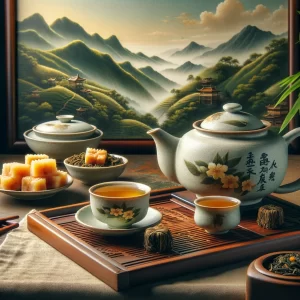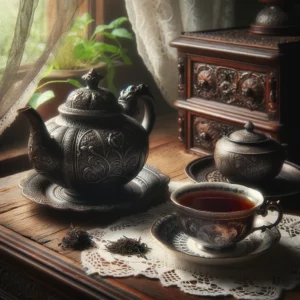Discover the captivating world of Alishan Oolong Tea, a gem among tea varieties with a rich aroma and complex flavor profile that charms tea lovers worldwide. This blog post embarks on an in-depth exploration of Alishan Oolong Tea, from its origins in the mist-covered mountains of Taiwan to the art of brewing the perfect cup. Join us as we uncover the secrets behind its cultivation, the nuances of its flavor, and the best ways to enjoy this exquisite tea.
Brief Description:
Alishan Oolong Tea is not just a beverage; it’s an experience. With its unique floral notes and smooth taste, this tea has garnered a devoted following. Our journey will take us through the history, cultivation, and preparation of Alishan Oolong Tea, providing tea enthusiasts with the knowledge to fully appreciate and savor this exceptional tea.
Table of Contents:
- The Origins and History of Alishan Oolong Tea
- What Makes Alishan Oolong Tea Special?
- Brewing the Perfect Cup
- Ways to Enjoy Alishan Oolong Tea
- The Best Pairings for Alishan Oolong Tea
- Where to Find Alishan Oolong Tea and Storage Tips
- Cultivation and Processing
- Conclusion
The Origins and History of Alishan Oolong Tea
Alishan Oolong Tea, named after the Alishan mountain range in Taiwan, is renowned for its superior quality and distinct flavor. Alishan is one of Taiwan’s most famous tea-growing areas, blessed with rich soil and a perfect climate for tea cultivation. The history of Alishan Oolong Tea dates back to the late 19th century when tea farmers recognized the potential of the region’s high elevation and misty climate for producing outstanding oolong tea.
Key Historical Points:
- Discovery: Tea cultivation in Alishan began when settlers discovered the area’s conducive growing conditions.
- Popularity: The unique characteristics of Alishan Oolong quickly gained recognition, both domestically and internationally.
- Cultural Significance: A symbol of Taiwanese tea culture, Alishan Oolong represents the fusion of traditional tea-making techniques with the island’s rich natural resources.
What Makes Alishan Oolong Tea Special?
Alishan Oolong Tea is celebrated for its light, floral aroma and a smooth, creamy flavor that lingers on the palate. The elevation at which it’s grown, ranging from 1000 to 2300 meters, contributes to its distinct taste profile. These teas are lightly oxidized, resulting in a greener, more vibrant leaf and a fresher brew than more heavily oxidized oolongs.
Unique Characteristics:
- Flavor Profile: A balance of sweet and floral notes with a hint of creaminess.
- Appearance: Bright green and tightly rolled leaves that unfurl beautifully when brewed.
- Aroma: A captivating floral scent with underlying fresh, vegetal notes.
Brewing the Perfect Cup
Brewing Alishan Oolong Tea is an art form that enhances its natural flavors and aromas. Here’s how to brew the perfect cup:
- Water Temperature: Use water at about 85°C to 95°C (185°F to 205°F) to avoid burning the leaves.
- Tea Quantity: Use about 5 grams of tea leaves for every 250 ml of water.
- Steeping Time: Start with a steeping time of 1 to 2 minutes and adjust to taste. Alishan Oolong can be re-steeped several times, with each infusion revealing new layers of flavor.
Brewing Tips:
- Pre-warm your teapot and cups to maintain the temperature of the tea.
- Use filtered water for the best taste.
- Experiment with steeping times to find your perfect brew.
Ways to Enjoy Alishan Oolong Tea
Alishan Oolong Tea is versatile, offering various ways to enjoy its exquisite flavors:
- Plain: Savor it without any additions to appreciate its natural flavors fully.
- Iced: Brew a stronger batch, let it cool, and serve over ice for a refreshing drink.
- In Recipes: Use it as a base for cocktails or in baking to infuse dishes with its unique flavor.
Creative Recipes:
- Alishan Oolong Tea-infused cakes or cookies.
- Cocktails mixed with a brew of Alishan Oolong.
The Best Pairings for Alishan Oolong Tea
Pairing food with Alishan Oolong Tea can enhance both the tea and the dining experience. Here are some suggestions:
- Light Snacks: Such as nuts or dried fruits to complement the tea’s natural sweetness.
- Seafood Dishes: The subtle flavors of seafood pair wonderfully with the floral notes of Alishan Oolong.
- Desserts: Pair it with light, fruit-based desserts for a delightful finish to any meal.
Where to Find Alishan Oolong Tea and Storage Tips
Selecting High-Quality Alishan Oolong:
Look for tea that comes directly from Taiwan and offers information about the tea’s harvest season and elevation. These details often indicate a higher-quality product.
Storage Tips:
- Keep it in a cool, dark place away from strong odors.
- Use an airtight container to preserve its flavors and aromas.
Cultivation and Processing
The cultivation of Alishan Oolong Tea is a meticulous process that requires careful attention to detail:
- Elevation: Grown at high elevations in the Alishan region, where cooler temperatures and misty conditions prevail.
- Harvesting: Leaves are hand-picked in the spring and autumn when the tea’s flavor is at its peak.
- Processing: Includes withering, rolling, partial oxidation, and drying—a process that’s carefully managed to achieve the desired flavor profile.
Conclusion
Alishan Oolong Tea offers a unique journey through its delicate flavors, rich history, and the art of tea brewing. By exploring its origins, understanding the care that goes into its cultivation and processing, and learning how to brew and enjoy it, tea enthusiasts can deepen their appreciation for this exceptional tea. Whether you’re a seasoned tea connoisseur or new to the world of oolong, Alishan Oolong Tea is a delightful discovery that invites you to explore the rich tapestry of Taiwanese tea culture.
Embrace the elegance of Alishan Oolong Tea and let its flavors inspire your tea journey.
Try Alishan Oolong Tea
“As an Amazon Associate I earn from qualifying purchases.”
[azonpress template=”grid” asin=”B0855YZGTW,B095HJXW1M,B01MU827SM,B09DSTYMZZ,B00PXPEUSA,B0D2L861B3″]



